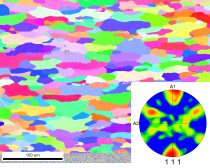Analytical methods of electron diffraction in a SEM
|

|
After successfully completing the module, students will be able to select application- and solution-oriented analytical methods of electron diffraction in the scanning electron microscope for a specific problem, and interpret and
evaluate the generated measurement data based on the knowledge and understanding of the module content. For these problems, they will be able to
distinguish between essential and non-essential data components. They will
be able to critically evaluate images, individual electron backscatter diffraction patterns, and maps.
After successfully completing this course, the students will have the ability to
create and apply computation-based analysis strategies based on competencies gained from computational training on real electron backscatter diffraction data.
|
Inhalte
- Crystal structure and electron backscatter diffraction (EBSD) – Kikuchi band
positions and intensities (including excess and deficiency characteristics)
- Practical imaging of the electron backscatter diffraction pattern (EBSP); gnomic projection and pattern center
- Phase identification and orientation determination based on electron backscatter diffraction patterns – Hough/Radon space-based indexing; pattern matching Different quality parameters for indexing solutions
- Information in EBSD maps (orientations, misorientations, (special) grain
and phase boundaries, quality parameters)
- Quantification of misorientations and orientation gradients (including kernel average misorientation; geometrically necessary dislocations)
- Quantification of orientation relationships and habitus planes (5-parameter form) based on EBSD data
- Cause, detection, and handling of pseudosymmetry in EBSPs during phase identification and orientation determination
- Use of background information, imaging with forward-scatter electron detectors and EBSD detectors
- Presentation of typical software (HKL Channel 5, TEAM EBSD, DynamicS, MTEX, CALM etc.)
|
Lehrform
2 hours per week lecture, 2 hours per week exercises, both in-person.
|
Rahmenbedingungen
Verantwortliche Lehrperson
Dr.-Ing. Hanka Becker, FMB
Voraussetzungen für die Teilnahme
Basic understanding of materials.
Prüfungsleistung
Klausur, 90 Minuten
Unterlagen
Das Vorlesungsskript und weitere Informationen werden auf der eLearning Plattform der OVGU zur Verfügung gestellt.
|

